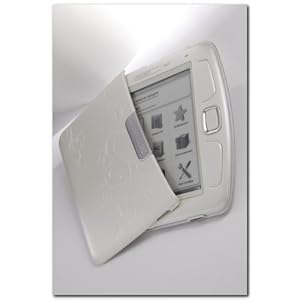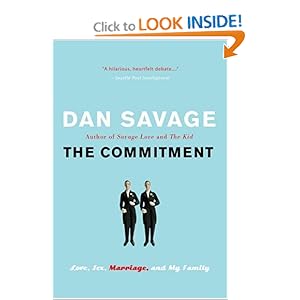- It had to be small. Whatever you're thinking, probably smaller than that. Bigger than my phone, but still very small. I read everywhere. I read in restaurants, I read on the train, I read in waiting rooms all over Long Island. My dream would be to put a bunch of books in my purse without having to carry a purse the size of a small overnight bag.
- It had to be lightweight--ideally under 8 oz. Mostly this isn't an issue when you're already satisfying the "it has to be tiny" criterion, but all other things being equal, a light ereader would be better than a heavy one. If I hand my purse to someone today, their immediate comment is that it feels like lead. I have enough back problems as it is. (Anyone ever read A Walk in the Woods? I find the passage where Katz hurls everything in his pack off the mountain strangely cathartic.)
- I wanted to try an e-ink reader. My eyes aren't the best, and e-ink is supposed to be this amazingly relaxing reading experience, and I really want to see whether I agree. I'm an Android fan, and I'd love an Android e-reader, but for now I'm sticking with e-ink screens.
- I wanted the background of the display to be as white as possible--as book-like as the technology would allow at my price point.
- I don't like proprietary stuff. So no Kindle, at least not for now. Kindroid, maybe, because I have to admit Amazon's selection seems to be unparalleled, but for now epub support will be just fine.
- It had to be around $200--originally I was shooting for $150. I don't even know if I'll enjoy an e-ink screen, so the less expensive, the better.
 The Sony Pocket Pro is the least expensive. The Sony was running $199 until recently, but can now be found on Amazon for just $155--and it comes in pretty colors. It has a pretty devoted following. I looked at it first, mainly because you can see them in person at Target and Borders, where you can touch them and hold them and try reading on them. I was disappointed in the e-ink experience with the Sony. It was like reading a solar calculator. I wanted to like it ($150 is a great price), but all I could think was "if this is the future of reading, I'm going to kill myself." It was also a little low on memory compared to its competitors, and the battery is not user-replaceable. But mostly, it was the display. For purposes of comparison, I checked out the Nook. I found that it was much better, although it did look calculatorish in certain light conditions. So I'm hopeful that what I end up with will be less depressing.
The Sony Pocket Pro is the least expensive. The Sony was running $199 until recently, but can now be found on Amazon for just $155--and it comes in pretty colors. It has a pretty devoted following. I looked at it first, mainly because you can see them in person at Target and Borders, where you can touch them and hold them and try reading on them. I was disappointed in the e-ink experience with the Sony. It was like reading a solar calculator. I wanted to like it ($150 is a great price), but all I could think was "if this is the future of reading, I'm going to kill myself." It was also a little low on memory compared to its competitors, and the battery is not user-replaceable. But mostly, it was the display. For purposes of comparison, I checked out the Nook. I found that it was much better, although it did look calculatorish in certain light conditions. So I'm hopeful that what I end up with will be less depressing.So $150 was out--now I was looking at two significantly more expensive readers. Well, at first I was looking at one slightly more expensive reader. The Opus was running about $180 when I started looking (and it's still available at that price). But when I started looking at reviews, I noticed that a new version was coming out that boasted instant-on functionality and faster page turns. I'm a deeply impatient person, so I started looking at the new model, which runs $200.
 The Opus is tiny--it is practically miniature--6" x 4.2" x .4" (one Amazon reviewer says it is a little larger than a frozen waffle). It is also incredibly light at only 5.3 oz. Of course the trade-off is that it is made of plastic, whereas the heavier but barely-larger Sony has an aluminum casing. The consensus in forums and reviews seemed to be that the Opus was clever and nice but overpriced--it originally sold for $280. At $180 or even $200, it seemed like a decent investment. And I was pretty sold when I saw a blogger's photo comparing its e-ink screen to a physical book (and not just any book, but one of my favorites), here. (I tried to embed it, but Blogger wants to make it ludicrously huge.) I would say "500 points to anyone who recognizes the book," but honestly, I think all our IR's will know it instantly.
The Opus is tiny--it is practically miniature--6" x 4.2" x .4" (one Amazon reviewer says it is a little larger than a frozen waffle). It is also incredibly light at only 5.3 oz. Of course the trade-off is that it is made of plastic, whereas the heavier but barely-larger Sony has an aluminum casing. The consensus in forums and reviews seemed to be that the Opus was clever and nice but overpriced--it originally sold for $280. At $180 or even $200, it seemed like a decent investment. And I was pretty sold when I saw a blogger's photo comparing its e-ink screen to a physical book (and not just any book, but one of my favorites), here. (I tried to embed it, but Blogger wants to make it ludicrously huge.) I would say "500 points to anyone who recognizes the book," but honestly, I think all our IR's will know it instantly.At this point I'd like to point out that the $180 Opus should have been my decision. It's got great reviews, it has a loyal following, and the firmware that makes the $200 version faster (it doesn't have a faster processor or more RAM or anything like that) will probably be available for the older model, if it isn't already. So it would be the smart choice. But I'm a girl, and the $200 version also comes colors other than white. What can I say? It's not smart, but it's pretty.
 As I was lurking in forums and combing through reviews, I came across the third contender, which almost seduced me. It is the Pocketbook 360. The hardware is very Opus-like (about the same size, same weight), but with a hard cover that goes over the screen (it detaches and snaps onto the back of the reader while you're using it). But the firmware is its true allure, praised by everyone who tries it. The ease of navigation! The ability to highlight! The apps! The incredibly sexy notion of tipping the book to turn the page without pressing a button! (No, seriously--the software senses the motion via the 360's accelerometer and turns the page. It was almost worth the extra $40 to me, and I have no idea why. I mean, it's cool and all, but I don't know why it's such a disproportionately attractive notion to me.) A lot of Opus users convert to Pocketbook 360, lured by its sexy, sexy firmware.
As I was lurking in forums and combing through reviews, I came across the third contender, which almost seduced me. It is the Pocketbook 360. The hardware is very Opus-like (about the same size, same weight), but with a hard cover that goes over the screen (it detaches and snaps onto the back of the reader while you're using it). But the firmware is its true allure, praised by everyone who tries it. The ease of navigation! The ability to highlight! The apps! The incredibly sexy notion of tipping the book to turn the page without pressing a button! (No, seriously--the software senses the motion via the 360's accelerometer and turns the page. It was almost worth the extra $40 to me, and I have no idea why. I mean, it's cool and all, but I don't know why it's such a disproportionately attractive notion to me.) A lot of Opus users convert to Pocketbook 360, lured by its sexy, sexy firmware.I seriously considered the 360, but eventually it lost out on points. First, it's more expensive. Second, and I apologize for being all hung up on aesthetics, it's really not attractive. It comes in two styles, white and girly or black and sadly geometric. The whirly-girly or geometric designs are molded into the cover, so you couldn't skin them and make them go away. There's also something squat about its proportions, and there was something else about it that I couldn't put my finger on. Then I asked my buddy at work, and he said, "Get the Opus. The Pocketbook has a Fisher-Price look about it." Yep, that's what it was.
So after all this dithering, I went to order the Opus, and it turns out that the French website kind of hates me. I'm waiting for them to come in on Monday and help me troubleshoot my order, which seems stuck in some kind of "pending" status. But folks at Mobileread have theirs and are excited about them, so I'm hopeful. I'll post more about the device as I get familiar with it.


2 comments:
How exciting! You have to tell us how the reader works when you get it. Very cool.
Yes, please do keep posting about how you like the ereader (once you get it).
And I do recognize that book, and it made me very happy.
Sara
Post a Comment